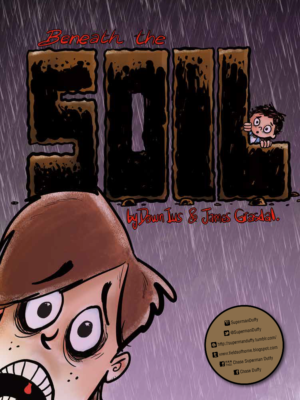
Grade 6 Learning Objectives for “Beneath the Soil”
Jump to Subject

English Language Arts
General Learning Objective
1. Students will listen, speak, read, write, view and represent to explore thoughts, ideas, feelings and experiences.
Specific Learning Objectives
1.1 Discover and Explore
Express ideas and develop understanding
- Use prior experiences with oral, print and other media texts to choose new texts that meet learning needs and interests
- Read, write, represent and talk to explore and explain connections between prior knowledge and new information in oral, print and other media texts
Experiment with language and forms
- Experiment with a variety of forms of oral, print and other media texts to discover those best suited for exploring, organizing and sharing ideas, information and experiences
1.2 Clarify and Extend
Combine ideas
- Use talk, notes, personal writing and representing, together with texts and the ideas of others, to clarify and shape understanding
- Evaluate the usefulness of new ideas, techniques and texts in terms of present understanding
General Learning Objective
2. Students will listen, speak, read, write, view and represent to comprehend and respond personally and critically to oral, print and other media texts.
Specific Learning Objectives
2.1 Use Strategies and Cues
Use prior knowledge
- Combine personal experiences and the knowledge and skills gained through previous experiences with oral, print and other media texts to understand new ideas and information
- Apply knowledge of organizational structures of oral, print and other media texts to assist with constructing and confirming meaning
Use comprehension strategies
- Identify, and explain in own words, the interrelationship of the main ideas and supporting details
- Use definitions provided in context to identify the meanings of unfamiliar words
- Monitor understanding by evaluating new ideas and information in relation to known ideas and information
Use phonics and structural analysis
- Use the meanings of prefixes and suffixes to predict the meanings of unfamiliar words in context
- Integrate and apply knowledge of phonics, sight vocabulary, language and context clues, and structural analysis to read unfamiliar words in texts of increasing length and complexity
2.2 Respond to Texts
Experience various texts
- Experience oral, print and other media texts from a variety of cultural traditions and genres, such as autobiographies, travelogues, comics, short films, myths, legends and dramatic performances
- Explain own point of view about oral, print and other media texts
- Make connections between own life and characters and ideas in oral, print and other media texts
- Discuss common topics or themes in a variety of oral, print and other media texts
- Discuss the author’s, illustrator’s, storyteller’s or filmmaker’s intention or purpose
Construct meaning from texts
- Observe and discuss aspects of human nature revealed in oral, print and other media texts, and relate them to those encountered in the community
- Summarize oral, print or other media texts, indicating the connections among events, characters and settings
- Identify or infer reasons for a character’s actions or feelings
- Make judgements and inferences related to events, characters, setting and main ideas of oral, print and other media texts
2.3 Understand Forms, Elements and Techniques
Understand forms and genres
- Identify key characteristics of a variety of forms or genres of oral, print and other media texts
Understand techniques and elements
- Discuss the connections among plot, setting and characters in oral, print and other media texts
- Identify first and third person narration, and discuss preferences with reference to familiar texts
- Explore techniques, such as visual imagery, sound, flashback and voice inflection, in oral, print and other media texts
General Learning Objective
3. Students will listen, speak, read, write, view and represent to manage ideas and information.
Specific Learning Objectives
3.1 Plan and Focus
Focus attention
- Use note-taking or representing to assist with understanding ideas and information, and focusing topics for investigation
General Learning Objective
5. Students will listen, speak, read, write, view and represent to respect, support and collaborate with others.
Specific Learning Objectives
5.1 Respect Others and Strengthen Community
Appreciate diversity
- Share and discuss ideas and experiences that contribute to different responses to oral, print and other media texts

Health
Topic: Safe and Responsibility
General Learning Objective
Wellness Choices
Students will make responsible and informed choices to maintain health and to promote safety for self and others.
Specific Learning Objectives
W–6.10
- Demonstrate responsibility for, and skills related to, the safety of self and others; e.g., baby-sitting, staying home alone, demonstrating Heimlich manoeuvre/ abdominal thrust techniques

Science
General Learning Objective
6–4 Demonstrate positive attitudes for the study of science and for the application of science in responsible ways.
Specific Learning Objectives
Students will show growth in acquiring and applying the following traits:
- Curiosity
- Confidence in personal ability to learn and develop problem-solving skills
- Flexibility in considering new ideas
- A willingness to work with others in shared activities and in sharing of experiences
- Appreciation of the benefits gained from shared effort and cooperation
- Respect for living things and environments, and commitment for their care.
